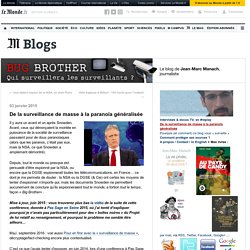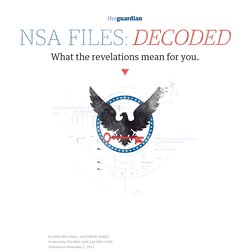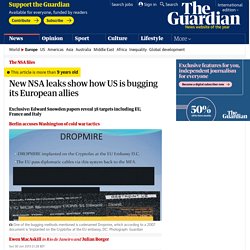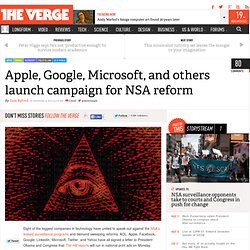

De la surveillance de masse à la paranoïa généralisée. Il y aura un avant et un après Snowden.

Avant, ceux qui dénonçaient la montée en puissance de la société de surveillance passaient pour de doux paranoïaques (alors que les paranos, c’était pas eux, mais la NSA, ce que Snowden a amplement démontré). Depuis, tout le monde ou presque est persuadé d’être espionné par la NSA, ou encore que la DGSE espionnerait toutes les télécommunications, en France… ce dont je me permets de douter : la NSA ou la DGSE (& Cie) ont certes les moyens de tenter d’espionner n’importe qui, mais les documents Snowden ne permettent aucunement de conclure qu’ils espionneraient tout le monde, a fortiori tout le temps, façon « Big Brother« .
Mise à jour, juin 2015 : vous trouverez plus bas la vidéo de la suite de cette conférence, donnée à Pas Sage en Seine 2015, où j’ai tenté d’expliquer pourquoi je n’avais pas particulièrement peur des « boîtes noires » du Projet de loi relatif au renseignement, et pourquoi le problème me semble être ailleurs…
NSA leak reveal plans to subvert mobile network security around the world. N.S.A. Collecting Millions of Faces From Web Images. The is harvesting huge numbers of images of people from communications that it intercepts through its global surveillance operations for use in sophisticated facial recognition programs, according to top-secret documents.

The spy agency’s reliance on facial recognition technology has grown significantly over the last four years as the agency has turned to new software to exploit the flood of images included in emails, text messages, social media, videoconferences and other communications, the N.S.A. documents reveal. Agency officials believe that technological advances could revolutionize the way that the N.S.A. finds intelligence targets around the world, the documents show.
The agency’s ambitions for this highly sensitive ability and the scale of its effort have not previously been disclosed. Photo One N.S.A. N.S.A. Devises Radio Pathway Into Computers. Photo WASHINGTON — The National Security Agency has implanted software in nearly 100,000 computers around the world that allows the United States to conduct surveillance on those machines and can also create a digital highway for launching cyberattacks.

While most of the software is inserted by gaining access to computer networks, the N.S.A. has increasingly made use of a secret technology that enables it to enter and alter data in computers even if they are not connected to the Internet, according to N.S.A. documents, computer experts and American officials. The technology, which the agency has used since at least 2008, relies on a covert channel of radio waves that can be transmitted from tiny circuit boards and USB cards inserted surreptitiously into the computers. In some cases, they are sent to a briefcase-size relay station that intelligence agencies can set up miles away from the target.
How Nsa Uses Radio Frequencies. La NSA espionne aussi les ordinateurs non-connectés à internet. NSA broke privacy rules thousands of times per year, audit finds. Comment la NSA ignore les lois sur la vie privée et édulcore des rapports. Edward Snowden's not the story. The fate of the internet is. Repeat after me: Edward Snowden is not the story.

NSA files decoded: Edward Snowden's surveillance revelations explained. Two factors opened the way for the rapid expansion of surveillance over the past decade: the fear of terrorism created by the 9/11 attacks and the digital revolution that led to an explosion in cell phone and internet use.

But along with these technologies came an extension in the NSA’s reach few in the early 1990s could have imagined. Details that in the past might have remained private were suddenly there for the taking. Chris Soghoian. Prism ? Une surprise ? Pas vraiment non … New NSA leaks show how US is bugging its European allies. US intelligence services are spying on the European Union mission in New York and its embassy in Washington, according to the latest top secret US National Security Agency documents leaked by the whistleblower Edward Snowden.

PRISM : la théorie du gros zizi. Pour une autre innovation. Ca m’énèrve #libre #microsoft #NSA #hadopi #pellerin #peillon #maman. "Pourquoi stocker toutes nos vies sur des serveurs aux Etats-Unis ?" Jérémie Zimmermann, porte-parole de la Quadrature du Net, association de défense des droits et libertés des citoyens sur Internet, était l'invité d'un chat avec les lecteurs du Monde.fr, mercredi 12 juin.

Ark : Comment est-il possible que des programmes aussi sensibles que Prism puissent être approuvés par le Congrès américain, et que personne (le public) n'en sache rien ? Est-ce que l'objectif du programme est masqué ? Un acte du Congrès est public, me semble-t-il. Vaste question, qui a trait en grande partie à l'attitude des Etats-Unis à la suite des attentats du 11 septembre 2001. Une politique publique basée sur la peur a donné les pleins pouvoirs à l'antiterrorisme, dans une sorte de guerre permanente (un peu comme dans 1984, de George Orwell ?). How secure is the National Security Agency?
Many are concerned about the National Security Agency (NSA) collection of data on US companies and individuals and the very real possibility that it has a way of directly accessing the servers of the world's largest computing platforms: Google, Facebook, Microsoft, etc.

It's certainly a situation that deserves attention and concern. But what's missing in this discussion is this: how secure is the NSA's spying system? If a foreign entity wanted to spy on US companies or individuals, would it try to tackle the problem directly by targeting the specific company or individual in its electronic spying attempts? Opt out of PRISM, the NSA's global data surveillance program - PRISM BREAK. NSA/SEO by Jeremiah Johnson. NSA Haiku Generator. NSA-O-Matic. Tech Companies Concede to Surveillance Program. Connie Zhou/Google, via Associated Press A Google data center in Council Bluffs, Iowa. Google says it scrutinizes each government request and notifies users if it is allowed. declined to make it easier for the government. But other companies were more compliant, according to people briefed on the negotiations.
Apple, Google, Microsoft, and others launch campaign for NSA reform. Eight of the biggest companies in technology have united to speak out against the NSA's leaked surveillance programs and demand sweeping reforms.

AOL, Apple, Facebook, Google, LinkedIn, Microsoft, Twitter, and Yahoo have all signed a letter to President Obama and Congress that The Hill reports will run in national print ads on Monday. "We understand that governments have a duty to protect their citizens," begins the letter. "But this summer's revelations highlighted the urgent need to reform government surveillance practices worldwide. " The letter also appears on a new website, Reform Government Surveillance, which further outlines the group's positions. "This summer's revelations highlighted the urgent need to reform government surveillance practices worldwide. " U.S., British intelligence mining data from nine U.S. Internet companies in broad secret program. The National Security Agency and the FBI are tapping directly into the central servers of nine leading U.S.

Internet companies, extracting audio and video chats, photographs, e-mails, documents, and connection logs that enable analysts to track foreign targets, according to a top-secret document obtained by The Washington Post. The program, code-named PRISM, has not been made public until now. It may be the first of its kind. The NSA prides itself on stealing secrets and breaking codes, and it is accustomed to corporate partnerships that help it divert data traffic or sidestep barriers. But there has never been a Google or Facebook before, and it is unlikely that there are richer troves of valuable intelligence than the ones in Silicon Valley.
Yahoo webcam images from millions of users intercepted by GCHQ. Britain's surveillance agency GCHQ, with aid from the US National Security Agency, intercepted and stored the webcam images of millions of internet users not suspected of wrongdoing, secret documents reveal. GCHQ files dating between 2008 and 2010 explicitly state that a surveillance program codenamed Optic Nerve collected still images of Yahoo webcam chats in bulk and saved them to agency databases, regardless of whether individual users were an intelligence target or not.
In one six-month period in 2008 alone, the agency collected webcam imagery – including substantial quantities of sexually explicit communications – from more than 1.8 million Yahoo user accounts globally. NSA slides explain the PRISM data-collection program. NSA Prism program taps in to user data of Apple, Google and others. The National Security Agency has obtained direct access to the systems of Google, Facebook, Apple and other US internet giants, according to a top secret document obtained by the Guardian. The NSA access is part of a previously undisclosed program called Prism, which allows officials to collect material including search history, the content of emails, file transfers and live chats, the document says.